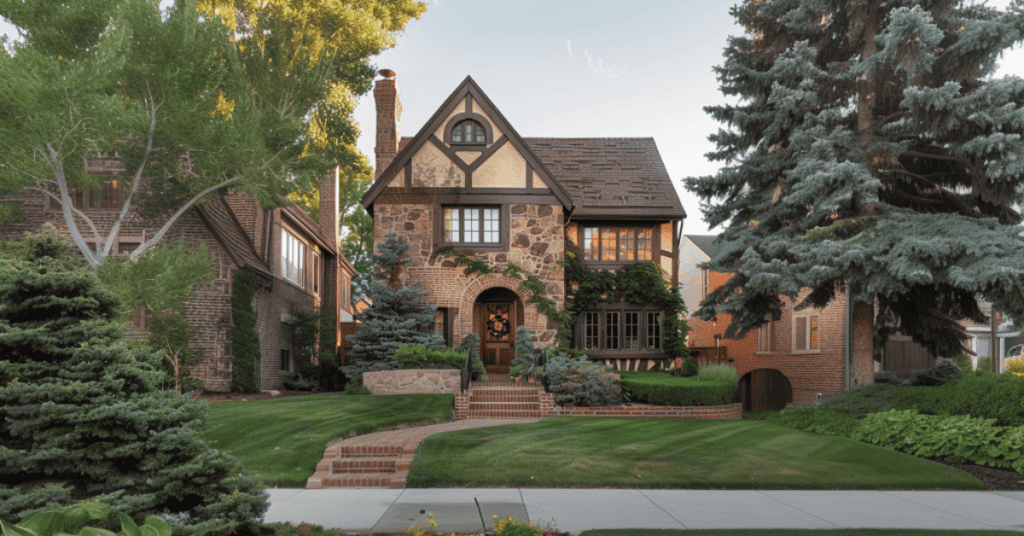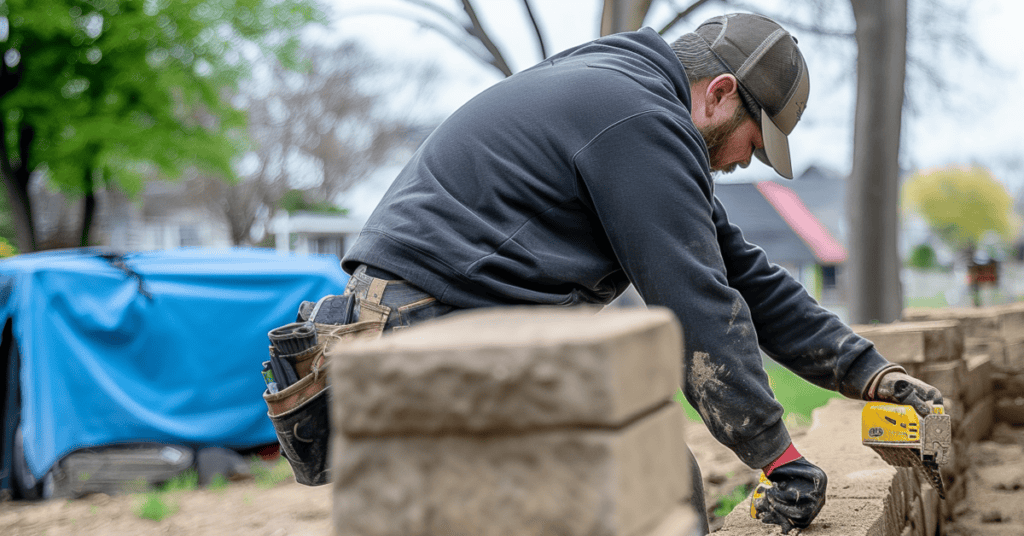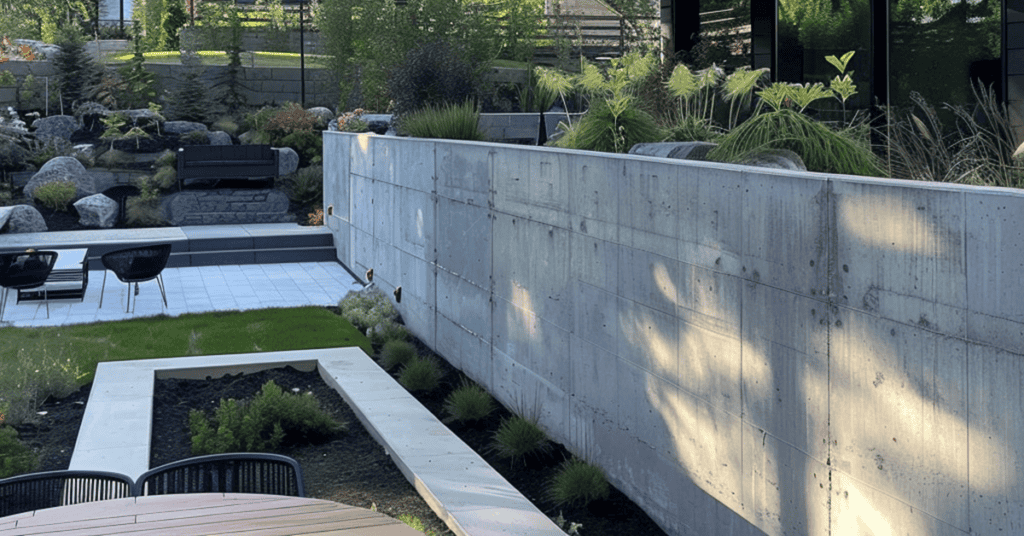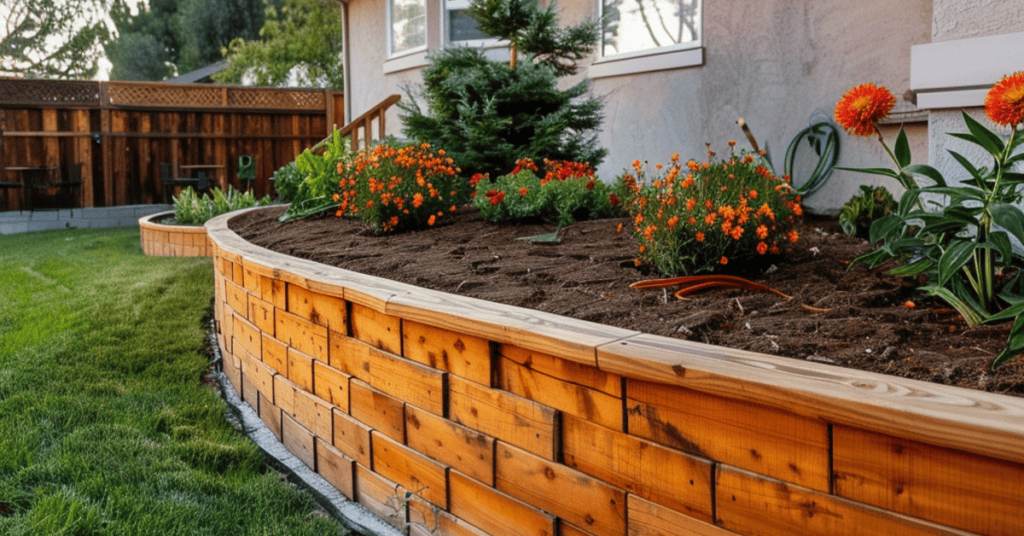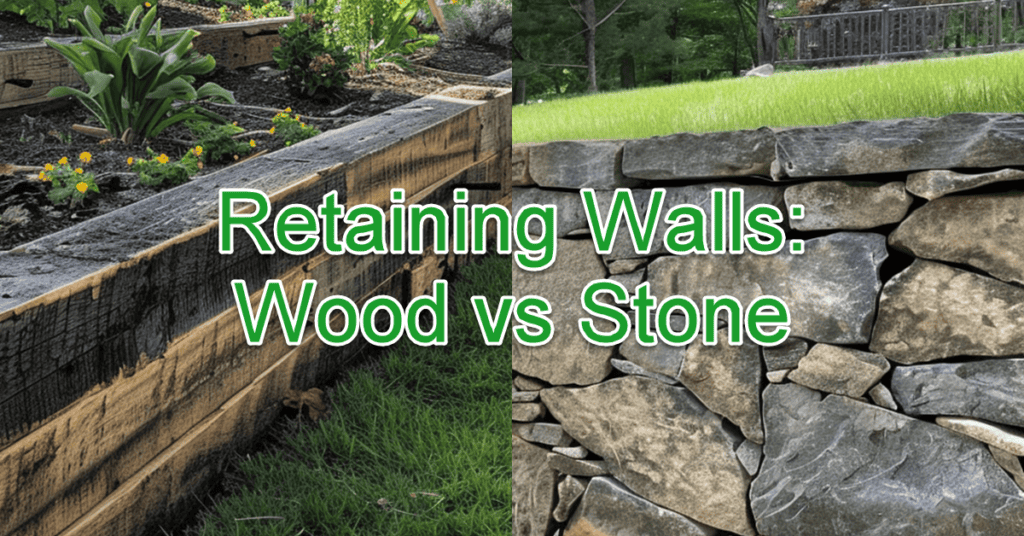Different Than Organic Landscaping Elements
A Hardscape element refers to the non-living (inorganic) elements of landscaping. These elements are often made from materials like stone, concrete, brick, and metal. Examples include patios, walkways, retaining walls, outdoor kitchens and pergolas.
In landscaping, hardscape plays a crucial role by providing structure to an outdoor space. While plants and grass offer natural beauty, hardscaping adds functionality and durability.
Key Features of Hardscape
- Patios: Create comfortable areas for seating and entertainment.
- Walkways: Guide visitors through a garden or yard.
- Retaining Wall: Prevent soil erosion and manage land slopes.
- Decks and Pergolas: Extend living spaces outdoors.
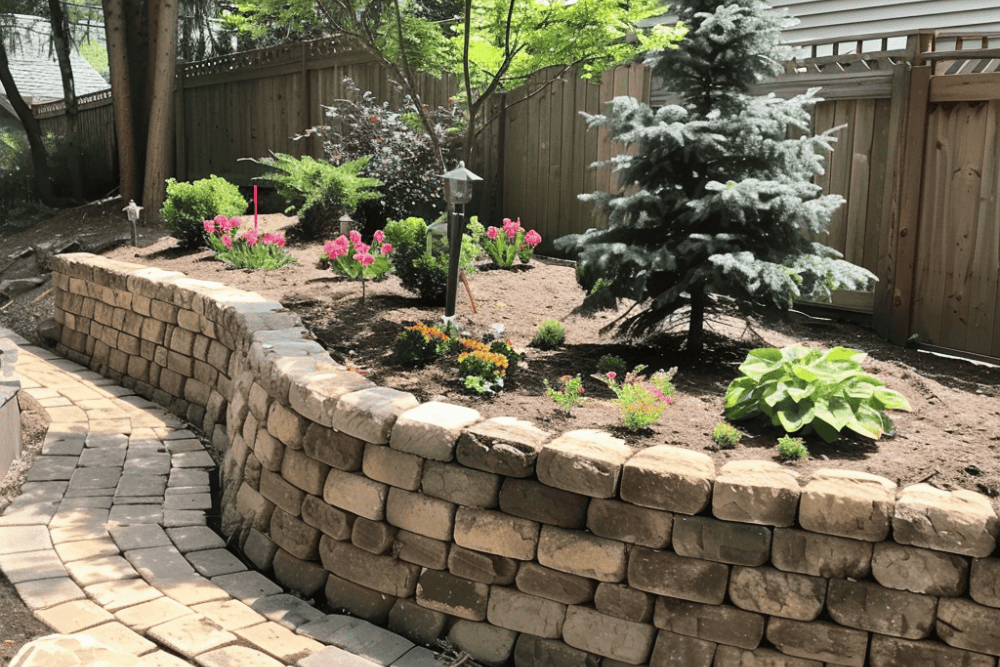
Retaining Walls Prevent Erosion and Create More Usable Space on Your Property
Benefits of Hardscape in Landscaping
- Durability: Hardscape materials are long-lasting and can withstand weather conditions.
- Low Maintenance: Unlike plants, non-living elements require minimal upkeep.
- Aesthetic Appeal: Adds visual interest and complements softscape elements like plants and flowers.
- Increased Property Value: Enhances the overall design of the landscape, making it more attractive to buyers.
Hardscaping vs Landscaping: What’s the difference
Combining Hardscape and Softscape
A well-designed landscape uses both hardscaping and softscaping. Hard elements provide structure and functionality, while softscape adds color and texture. For example, a stone pathway leading to a garden creates a balance between the natural and the man-made.
Hardscape elements like outdoor kitchens and fire pits turn a plain backyard into a livable area perfect for gatherings. Concrete pavers and gravel paths create defined spaces for different outdoor activities. This blend makes any landscape both beautiful and practical.
Key Hardscaping Elements and Materials
Natural Stone
Natural stone is a popular choice in hardscaping for its beauty and durability. Common types include limestone, flagstone, and granite. Limestone is known for its smooth texture and is often used for patios and pathways. Flagstone comes in a range of colors and is excellent for walkways and patios due to its flat surfaces. Granite is extremely hard and is frequently used for high-traffic areas like driveways.
Concrete and Pavers
Concrete is a versatile hardscape material. Concrete pavers are pre-made blocks that are used for constructing driveways, walkways, and patios. They come in various shapes, sizes, and colors, which allows for creative designs.
Stamped concrete can mimic the appearance of other materials like stone or brick but with the strength and longevity of concrete. Pavers are particularly popular due to their durability and low maintenance requirements.
Wood and Composite Options
Wood provides a natural and warm look to any outdoor space. Common types include pressure-treated lumber and cedar. Pressure-treated lumber is resistant to insects and decay, making it a durable choice for decking. Cedar is naturally resistant to moisture and rot, suitable for pergolas and other wooden structures.
Composite materials, made from a blend of wood fibers and plastic, offer the natural appearance of wood without the high maintenance. They resist warping, rotting, and are ideal for decking and garden structures.
Design Principles for Hardscaping
Balancing Hardscape with Softscape
Balancing hardscape with softscape is essential for a harmonious outdoor space. Hardscape elements such as pathways, patios, and retaining walls should coexist seamlessly with plants, trees, and lawns (softscape).
To achieve this balance, consider the proportion and scale of hard elements in relation to green areas. Too much hardscape can make a space feel harsh and uninviting, while too little can lack structure and purpose.
Using curved lines rather than straight ones can soften the transition between hard and soft elements. Incorporating raised planters or embedding greenery within hardscape features like a patio with built-in garden beds can achieve a perfect balance, promoting both functionality and visual appeal.
Hardscape as Functional Spaces
As part of your overall landscape design, hardscape elements should serve specific purposes to enhance the usability of outdoor areas. Patios and decks provide spaces for outdoor dining and relaxation. Walkways offer easy and safe navigation around the garden.

A Variety of Patio Options Including Poured Concrete and Pavers Allow You to Achieve Your Desired Look
A retaining wall can create leveled garden beds and prevent soil erosion. Incorporating seating areas, outdoor kitchens, and fire pits can transform a backyard into an extension of the indoor living space.
Structural Features in Hardscaping
Hardscaping involves the incorporation of non-living elements that provide structure and functional aesthetics to outdoor spaces. This includes a variety of features such as retaining walls, patios, decks, walkways, water features, and outdoor kitchens.
Purposes of a Retaining Wall
Retaining walls are an essential hardscape feature in landscape design. They prevent soil erosion, manage water drainage, and create level areas on slopes. These walls can be made from materials like stone, concrete, or brick, and they help stabilize the landscape.
Patios and Decks as Living Spaces
Patios and decks extend indoor living spaces to the outdoors, allowing for comfortable lounging, dining, and entertaining. Patios, often made of concrete, stone, or pavers, provide a solid, low-maintenance surface. Decks, typically constructed from wood or composite materials, offer elevated spaces with potential for multi-level designs.
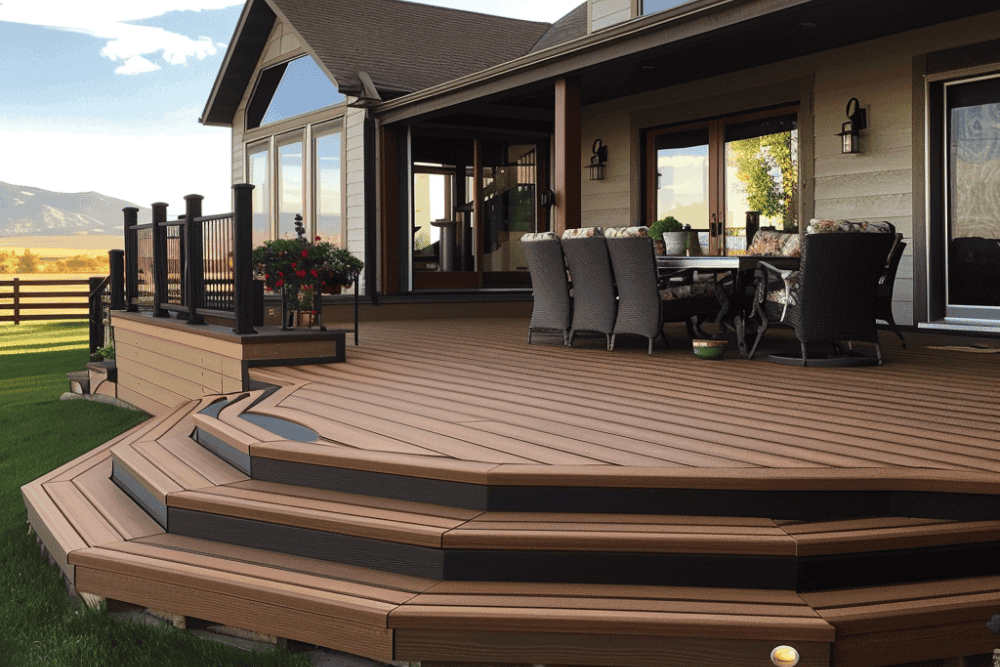
Composite Decks are a Stylish, Low Maintenance Decking Option
These structures can include features such as pergolas, gazebos, and outdoor kitchens. They blend well with other elements like gardens or pools. You can even add landscape lighting for a more elegant touch.
Walkways and Pathways
Walkways and pathways guide movement through an outdoor space, enhancing both aesthetics and function. Common materials for these paths include brick, stone, gravel, and concrete, chosen for durability and style.
Water Features and Points of Interest
Water features such as ponds, fountains, and waterfalls add tranquility and visual interest to a landscape. They serve as focal points in gardens and can attract wildlife like birds and frogs, enhancing the natural environment.
These elements range from simple birdbaths to elaborate koi fish ponds and multi-tiered fountains. Water features often require planning for proper water flow, filtration, and maintenance, but they offer calming sounds and a refreshing aesthetic to any outdoor area.
Selecting Hardscape Features
Creating Shade and Privacy
Creating shade and privacy in a yard involves selecting features like pergolas, gazebos, trees, shrubs, and fences. Pergolas and gazebos provide architectural interest and cool, shaded areas for relaxation. Trees and shrubs not only add natural beauty but also create private spaces when strategically placed. Fences and arbors are solid choices for defining boundaries and enhancing seclusion.
By combining these elements, homeowners can enjoy cooler spaces and have a retreat-like feel in their outdoor areas. For example, placing a pergola over a patio can offer relief from the sun and serve as a peaceful, private nook.
Choosing a Focal Point
The selection of a focal point is crucial in landscape design, guiding the viewer’s eye and creating visual interest. Options include water features, sculptures, or a carefully arranged set of planters. Courtyards can also serve as impressive focal points, offering a central, cohesive area in the landscape.
Water features, like fountains or ponds, add movement and sound that enhance the sensory experience. Beautifully designed outdoor kitchens can become a social gathering highlight. Trees or large shrubs can also act as natural focal points, drawing attention with their size and structure.
Outdoor Entertainment and Cooking
An outdoor kitchen really takes your outdoor living space to the next level. Considering outdoor entertainment and cooking areas is essential for those who enjoy hosting gatherings. Patios and decks act as the foundation for these spaces, accommodating seating, dining areas, and more. Installing an outdoor kitchen provides a dedicated space for cooking and food preparation, typically featuring grills, countertops, sinks, and sometimes even refrigerators.
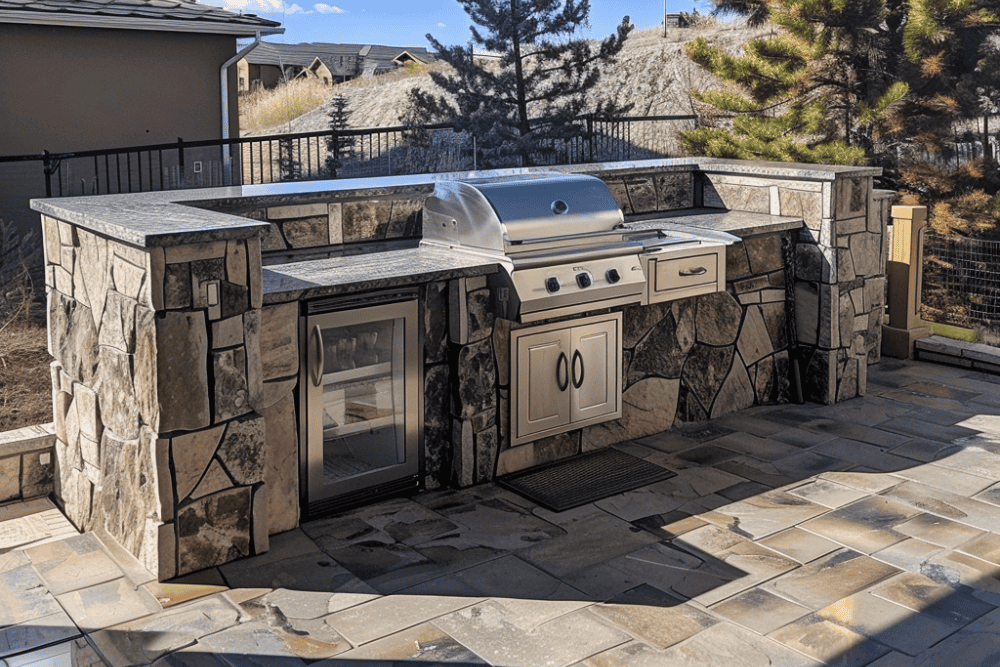
Outdoor Kitchens are Not Only Great for Entertaining – They Also Keep the Heat Outside During our Hot Summer Months Here in Colorado
For entertainment, cozy seating arrangements around fire pits or outdoor fireplaces make for great conversation spots. Adding a pergola over the outdoor kitchen or patio area can offer additional comfort and elegance, making the space usable even under bright sunlight.
Installation and Maintenance of Hardscape
Building Techniques and Durability
Hardscape installations involve several building techniques to ensure durability. Key elements include a solid base, proper materials, and professional craftsmanship. For example, patios and walkways often use concrete pavers, stone, or brick, placed on a compacted gravel and sand base. This offers stability and prevents shifting.
Permeable pavers are popular for their ability to allow water infiltration, reducing puddles and runoff. When you install features like retaining walls correctly, they provide structural support and prevent soil erosion. Professionals often recommend sealing surfaces to protect against weathering and stains. Planning and executing these steps correctly enhance the longevity and appearance of hardscape elements.
Solutions for Drainage and Soil Erosion
Managing water flow is critical in hardscape design to prevent issues like flooding and soil erosion. Installing drainage solutions such as French drains or dry wells can help direct water away from hardscape areas. These systems collect and redirect water to where it can safely flow away from where it can cause damage.
Slope management is another important aspect. Ensuring that patios and pathways are sloped away from buildings prevents water accumulation. Retaining walls and terraces also play a role in managing soil stability on sloped landscapes. Installing permeable pavers allows water to seep through the surface, reducing runoff and erosion risks. These steps ensure a well-maintained hardscape that can withstand various weather conditions.
Ongoing Hardscape Care
Maintaining hardscape landscaping requires regular care to preserve its appearance and function. Surface cleaning, such as sweeping and pressure washing, keeps elements free of debris and prevents staining. Sealing surfaces every few years can protect against water damage and weathering.
Inspecting for cracks and repairing them promptly prevents further damage and maintains stability. Weed control is another task; using weed barriers or herbicides can keep hardscape areas looking neat. Considering low-maintenance plants in nearby softscaping can reduce the time spent on upkeep. Regular attention to these maintenance tasks ensures the hardscape remains a valuable and attractive part of the landscape.
Incorporating Safety and Comfort Features
Adding safety and comfort to the landscape is vital. Lighting along pathways and in dark areas ensures safety at night. Non-slip surfaces on patios and walkways prevent accidents.
Comfort features such as shaded areas with pergolas and outdoor furniture make the space enjoyable year-round. Adequate seating, fire pits, and water features offer both comfort and aesthetic appeal.
Safety measures like these not only protect but also enhance the appeal of outdoor living spaces, making them more usable and enjoyable for everyone.


